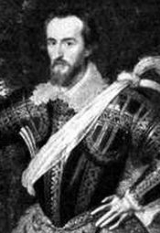
Sir James Scudamore
Encyclopedia
Sir James Scudamore (1568–1619) was a gentleman usher
at the court of Queen Elizabeth I. Born at Holme Lacy
, Herefordshire
, he was the eldest son of Sir John Scudamore
, Custos Rotulorum
of Herefordshire and his first wife Eleanor Croft, daughter of former Lord Deputy of Ireland
James Croft
. He would assume that title in 1616, and remained Custos Rotulorum for two years until his own death in 1619. Scudamore was respected for his tilting
skill and his embodiment of the ideals of chivalry
.
, who, as a poet, soldier, and courtier, exemplified the ideal high-born gentleman of the time. Scudamore sought to emulate Sidney, and befriended him as a teenager, becoming his protege. After Sidney died at the Battle of Zutphen
, James Scudamore carried his pennant of arms at his funeral in 1586, aged only eighteen years at the time. He can be seen carrying the pennant near the front of the procession in the funereal roll drawn by Thomas Lant
. Seeing himself as Sidney's successor, the young Scudamore sought to carry on the chivalric tradition with great zeal. He made a name for himself jousting in the tournament; he was one of the primary knights who took part in the Accession Day tilt
Seeing himself as Sidney's successor, the young Scudamore sought to carry on the chivalric tradition with great zeal. He made a name for himself jousting in the tournament; he was one of the primary knights who took part in the Accession Day tilt
of 1595. At this tournament, his shield was decorated with the motto "L'escu D'amour," the original Anglo-Norman
form of his surname which translated to "shield of love." The shield was shaped like a heart, and bore the image of a turtle. Scudamore cut a dashing figure at the tilt-yard – his appearance was thus recounted by the scholar William Higford:
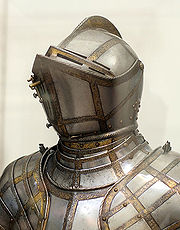 A knightte on horseback is the goodliest sight the worlde can presente to viewe; and is not lesse than a Prince...mee thinkes I see sir James Scudamore...enter the Tilte yarde in a handsome equippage all in compleate Armor, embelished with plumes, his beaver close, mounted vppon a verie highe boundinge horse. I haue seene the shoes of his horse glister aboue the heades of all the people. And when hee came to the encounter or shocke, brake as manie spearse as the beste, Her majestie Queene Elizabeth with a trayne of ladies like the starres in the firmamente, and the whole Courte lookinge vppon him with a verie gratious aspecte. And when hee came to reside with sir John Scudamore his father (two braver gentlemen shall I neuer see togeather att one time, much more a sonne and a father)...Holme Lacie att that time seemed not onlie an Academia, but euen the verie Courte of a Prince.
A knightte on horseback is the goodliest sight the worlde can presente to viewe; and is not lesse than a Prince...mee thinkes I see sir James Scudamore...enter the Tilte yarde in a handsome equippage all in compleate Armor, embelished with plumes, his beaver close, mounted vppon a verie highe boundinge horse. I haue seene the shoes of his horse glister aboue the heades of all the people. And when hee came to the encounter or shocke, brake as manie spearse as the beste, Her majestie Queene Elizabeth with a trayne of ladies like the starres in the firmamente, and the whole Courte lookinge vppon him with a verie gratious aspecte. And when hee came to reside with sir John Scudamore his father (two braver gentlemen shall I neuer see togeather att one time, much more a sonne and a father)...Holme Lacie att that time seemed not onlie an Academia, but euen the verie Courte of a Prince.
George Peele
, dramatist, wrote:
L’escu d’amour, the arms of loyalty/Lodg’d Skydmore in his heart; and on he came, And well and worthily demeaned himself/In that day’s service: short and plain to be, No Lord nor knight more foreard than was he.
Though by no means a particularly influential nobleman of the Elizabethan court, he was nonetheless greatly admired for his sporting skill. It is apparent from the dimensions of his suits of armour that he was powerfully-built and tall for his time, and he is recorded as having won first place in the Accession Day tilt at least once. The Queen's personal attendance of Scudamore's own tilt-yard at Holme Lacy is a testament to his gallant reputation.
He was a noted soldier, and served, among other places, at the Capture of Cadiz
, where he was knighted by the Earl of Essex
.
He is said to be the inspiration for the character of "Scudamour," a primary character in Book Four of The Faerie Queen by Edmund Spenser
. In the poem, Scudamour is a gallant knight who has had his lover Amoret stolen away from him. He spends the rest of the book unsuccessfully trying to find her; at one point he stops to rest and is tortured in his sleep by a blacksmith wielding a pair of tongs
. It is unknown whether this characterization is intended as a mockery of the actual Scudamore, a light-hearted joke, or an honest representation of his chivalry.
Scudamore officially retired from tilting in 1600. However, he and his father continued to train horses at Holme Lacy.
in 1601, and a member of Parliament for the Herefordshire
in 1601 and for several years thereafter. He was appointed to the council of the Welsh Marches on 12 November 1617, and subscribed £30 to the Virginia Company.
Scudamore was originally a Catholic, but he later renounced this religion, along with his father, soon after the turn of the century. After his conversion he became a fervent anti-Catholic and made efforts to curtail the practice of Catholicism. On June 19, 1605, he and three other county officials made a thirty-mile sweep along the border between Herefordshire and Monmouthshire to flush out Catholics. Accompanied by an armed band of men, they made a house by house and village by village search that lasted all night and into the next day. They found “altars, images, books of superstition, relics of idolatry” but no Catholics since they had fled west and south into Wales.
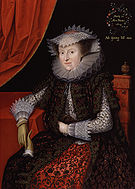 In March 1597, Scudamore was married to Mary Houghton, the daughter of a London alderman. She died within the year, and in 1598 he re-married to the widow of Sir Thomas Baskerville, coincidentally also named Mary. Research suggests that his marriage with Lady Mary Scudamore was turbulent. For reasons that are uncertain, she was disliked by the Scudamore family, and Sir James's relatives pressured them to end the marriage. They separated in 1604. Scudamore had two sons, John (1601–1671) and James (1606–1631), with his second wife, and another, Barnabas (1609–1652) with his third wife. His eldest son John succeeded his father's political offices and became 1st Viscount Scudamore
In March 1597, Scudamore was married to Mary Houghton, the daughter of a London alderman. She died within the year, and in 1598 he re-married to the widow of Sir Thomas Baskerville, coincidentally also named Mary. Research suggests that his marriage with Lady Mary Scudamore was turbulent. For reasons that are uncertain, she was disliked by the Scudamore family, and Sir James's relatives pressured them to end the marriage. They separated in 1604. Scudamore had two sons, John (1601–1671) and James (1606–1631), with his second wife, and another, Barnabas (1609–1652) with his third wife. His eldest son John succeeded his father's political offices and became 1st Viscount Scudamore
. James fought in campaigns in the Low Countries, and Barnabas served at the Battle of Newburn
under Colonel Charles Vavasour.
A cultured man and patron of literature, Scudamore was a great friend of scholar Thomas Bodley
, and contributed to the founding of the Bodleian Library
at Oxford
.
Scudamore was close with his father John; the two lived together at Holme Lacy
for the entirety of Sir James's life, where they trained horses together and hosted such cultural figures as Bodley, scientist John Dee
, the polymath Samuel Hartlib
and the mathematician Thomas Allen
. He was therefore privy to many significant scientific developments of the time. In one memorable incident, Thomas Allen was visiting the Scudamores at Holme Lacy, and was demonstrating his pocket watch
to his hosts – at that time, an extremely uncommon and novel device. Frightened by the loud ticking sound of the watch, a maid seized the timepiece and tossed it into a nearby stream. Though Herefordshire was regarded as somewhat of a rustic – even backwards – region, the Scudamore family's patronage of learned and illustrious cultural luminaries of the day ensured for them a high degree of social prestige and a prominent place at the court of the Queen.
Scudamore's stepmother – his father's second wife, Mary Shelton
– was a lady of the Privy Chamber
of Queen Elizabeth. When she married John Scudamore without permission, the Queen flew into a rage and assaulted her, breaking her finger.
The exact cause of Sir James Scudamore's death is not known; biographer Ian Atherton suggests that it may have stemmed from complications arising from an injured ("gammy") leg which he had been treated for in the past. His father outlived him by four years. In his will, Sir James bequeathed "My armor that I used to Weare" to his son John.
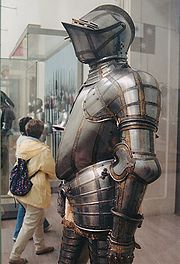
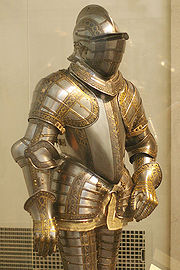 Sir James Scudamore left behind some of the finest surviving suits of armour from Elizabethan England, built at the royal Greenwich armory. His tournament armour features a distinctive close helmet
Sir James Scudamore left behind some of the finest surviving suits of armour from Elizabethan England, built at the royal Greenwich armory. His tournament armour features a distinctive close helmet
of the Greenwich style with a high visor and a raised crest; articulated tassets
and cuisses
, and cris-crossing strips of blued
steel inlaid with elaborate gold designs. Another armour, in the later cuirassier
style, features a burgonet
with a falling-buffe visor and detailed gilding and etching. It is in this armour that he is shown in his portrait which now hangs at Holme Lacy. It is obvious from the painting that the armour was originally colored a dark shade, and had been polished down to bare steel during its restoration. The pattern for this armour is identical to several others in the Jacob Album including William Compton, 1st Earl of Northampton
. A portrait of Compton shows him wearing an armour of more or less identical appearance.
Scudamore's suits of armour were discovered in 1911 packed away in a chest in the attic of an abandoned tower at Holme Lacy, in an extreme state of disrepair and significantly damaged by rust. They had been sitting in a chest beneath an eave through which water had been trickling down into a pool on the floor; they had likely been in this sorry condition for several hundred years. The owner of the estate at the time, Lord Chesterfield, put the armour up at auction for the sum of twenty pounds. A dealer who happened to notice it at the auction informed Chesterfield that it was worth far more, and purchased it for the sum of two thousand pounds. Later, Chesterfield happened by chance upon that dealer's shop, and saw the same armor for sale – for fifteen thousand pounds. Chesterfield sued the dealer and the armour was returned to him. The suits of armour were subsequently purchased by J. Pierpont Morgan and given to the Metropolitan Museum of Art
in New York City
, where they remain on display today.
Gentleman Usher
Gentleman Usher is a title for some officers of the Royal Household of the United Kingdom. See List of Gentlemen Ushers for a list of office-holders.-Historical:...
at the court of Queen Elizabeth I. Born at Holme Lacy
Holme Lacy
-Etymology:Holme Lacy is not from Old Norse holmr "island" like other places of the name Holme, but from the fairly similar Old English hamm "land in a river-bend". The name was recorded as Hamme in the Domesday Book in 1086...
, Herefordshire
Herefordshire
Herefordshire is a historic and ceremonial county in the West Midlands region of England. For Eurostat purposes it is a NUTS 3 region and is one of three counties that comprise the "Herefordshire, Worcestershire and Gloucestershire" NUTS 2 region. It also forms a unitary district known as the...
, he was the eldest son of Sir John Scudamore
John Scudamore (courtier)
Sir John Scudamore, as the eldest son of William Scudamore, but due to his father's early death was a ward of Sir James Croft of Croft Castle, Herefordshire, whose daughter Eleanor he married in 1563....
, Custos Rotulorum
Custos rotulorum
Custos rotulorum is the keeper of an English county's records and, by virtue of that office, the highest civil officer in the county...
of Herefordshire and his first wife Eleanor Croft, daughter of former Lord Deputy of Ireland
Lord Deputy of Ireland
The Lord Deputy was the King's representative and head of the Irish executive under English rule, during the Lordship of Ireland and later the Kingdom of Ireland...
James Croft
James Croft
Sir James Croft PC , Lord Deputy of Ireland and MP for Herefordshire in the Parliament of England.He was born the second but eldest surviving son of Richard Croft of Croft Castle, Herefordshire, inheriting the estate on his father's death in 1562.He was elected seven times as knight of the shire ...
. He would assume that title in 1616, and remained Custos Rotulorum for two years until his own death in 1619. Scudamore was respected for his tilting
Jousting
Jousting is a martial game or hastilude between two knights mounted on horses and using lances, often as part of a tournament.Jousting emerged in the High Middle Ages based on the military use of the lance by heavy cavalry. The first camels tournament was staged in 1066, but jousting itself did not...
skill and his embodiment of the ideals of chivalry
Chivalry
Chivalry is a term related to the medieval institution of knighthood which has an aristocratic military origin of individual training and service to others. Chivalry was also the term used to refer to a group of mounted men-at-arms as well as to martial valour...
.
Life as a courtier
Scudamore became something of a legend in his time at Elizabeth's court. As a young man he idolized Philip SidneyPhilip Sidney
Sir Philip Sidney was an English poet, courtier and soldier, and is remembered as one of the most prominent figures of the Elizabethan Age...
, who, as a poet, soldier, and courtier, exemplified the ideal high-born gentleman of the time. Scudamore sought to emulate Sidney, and befriended him as a teenager, becoming his protege. After Sidney died at the Battle of Zutphen
Battle of Zutphen
The Battle of Zutphen was a confrontation of the Eighty Years' War on 22 September 1586, near Zutphen , the Netherlands. It was fought between forces of the United Provinces of the Netherlands, aided by the English, against the Spanish, who sought to regain the northern Netherlands.Important...
, James Scudamore carried his pennant of arms at his funeral in 1586, aged only eighteen years at the time. He can be seen carrying the pennant near the front of the procession in the funereal roll drawn by Thomas Lant
Thomas Lant
Thomas Lant was a draftsman and long-serving officer of arms at the College of Arms in London. Lant was born in Gloucester and was one of seven children of Thomas and Mary Lant. When Lant was twelve years old, he became a page to Richard Cheney, the Bishop of Gloucester. When Cheney died in 1579,...
.

Accession Day tilt
The Accession Day tilts were a series of elaborate festivities held annually at the court of Elizabeth I of England to celebrate her Accession Day, 17 November, also known as Queen's Day...
of 1595. At this tournament, his shield was decorated with the motto "L'escu D'amour," the original Anglo-Norman
Anglo-Norman language
Anglo-Norman is the name traditionally given to the kind of Old Norman used in England and to some extent elsewhere in the British Isles during the Anglo-Norman period....
form of his surname which translated to "shield of love." The shield was shaped like a heart, and bore the image of a turtle. Scudamore cut a dashing figure at the tilt-yard – his appearance was thus recounted by the scholar William Higford:

George Peele
George Peele
George Peele , was an English dramatist.-Life:Peele was christened on 25 July 1556. His father, who appears to have belonged to a Devonshire family, was clerk of Christ's Hospital, and wrote two treatises on bookkeeping...
, dramatist, wrote:
L’escu d’amour, the arms of loyalty/Lodg’d Skydmore in his heart; and on he came, And well and worthily demeaned himself/In that day’s service: short and plain to be, No Lord nor knight more foreard than was he.
Though by no means a particularly influential nobleman of the Elizabethan court, he was nonetheless greatly admired for his sporting skill. It is apparent from the dimensions of his suits of armour that he was powerfully-built and tall for his time, and he is recorded as having won first place in the Accession Day tilt at least once. The Queen's personal attendance of Scudamore's own tilt-yard at Holme Lacy is a testament to his gallant reputation.
He was a noted soldier, and served, among other places, at the Capture of Cadiz
Capture of Cadiz
The Capture of Cádiz in 1596 was an event during the Anglo-Spanish War, when English and Dutch troops under Robert Devereux, 2nd Earl of Essex and a large Anglo-Dutch fleet under Charles Howard, 1st Earl of Nottingham, with support from the Dutch United Provinces, raided the Spanish city of...
, where he was knighted by the Earl of Essex
Robert Devereux, 2nd Earl of Essex
Robert Devereux, 2nd Earl of Essex, KG was an English nobleman and a favourite of Elizabeth I. Politically ambitious, and a committed general, he was placed under house arrest following a poor campaign in Ireland during the Nine Years' War in 1599...
.
He is said to be the inspiration for the character of "Scudamour," a primary character in Book Four of The Faerie Queen by Edmund Spenser
Edmund Spenser
Edmund Spenser was an English poet best known for The Faerie Queene, an epic poem and fantastical allegory celebrating the Tudor dynasty and Elizabeth I. He is recognised as one of the premier craftsmen of Modern English verse in its infancy, and one of the greatest poets in the English...
. In the poem, Scudamour is a gallant knight who has had his lover Amoret stolen away from him. He spends the rest of the book unsuccessfully trying to find her; at one point he stops to rest and is tortured in his sleep by a blacksmith wielding a pair of tongs
Tongs
Tongs are used for gripping and lifting tools, of which there are many forms adapted to their specific use. Some are merely large pincers or nippers, but the greatest number fall into three classes:...
. It is unknown whether this characterization is intended as a mockery of the actual Scudamore, a light-hearted joke, or an honest representation of his chivalry.
Scudamore officially retired from tilting in 1600. However, he and his father continued to train horses at Holme Lacy.
Political activities
Sir James Scudamore became the deputy lieutenant of Herefordshire on August 25, 1600. He was also made High Sheriff of HerefordshireHigh Sheriff of Herefordshire
The Sheriff is the oldest secular office under the Crown. Formerly the Sheriff was the principal law enforcement officer in the county but over the centuries most of the responsibilities associated with the post have been transferred elsewhere or are now defunct, so that its functions are now...
in 1601, and a member of Parliament for the Herefordshire
Herefordshire (UK Parliament constituency)
The county constituency of Herefordshire, in the West Midlands of England bordering on Wales, was abolished when the county was divided for parliamentary purposes in 1885...
in 1601 and for several years thereafter. He was appointed to the council of the Welsh Marches on 12 November 1617, and subscribed £30 to the Virginia Company.
Scudamore was originally a Catholic, but he later renounced this religion, along with his father, soon after the turn of the century. After his conversion he became a fervent anti-Catholic and made efforts to curtail the practice of Catholicism. On June 19, 1605, he and three other county officials made a thirty-mile sweep along the border between Herefordshire and Monmouthshire to flush out Catholics. Accompanied by an armed band of men, they made a house by house and village by village search that lasted all night and into the next day. They found “altars, images, books of superstition, relics of idolatry” but no Catholics since they had fled west and south into Wales.
Personal life

John Scudamore, 1st Viscount Scudamore
John Scudamore, 1st Viscount Scudamore , diplomat and politician, was the eldest son of Sir James Scudamore of Holme Lacy, Herefordshire....
. James fought in campaigns in the Low Countries, and Barnabas served at the Battle of Newburn
Battle of Newburn
The Battle of Newburn was fought on 28 August 1640 during the Second Bishops' War between a Scottish Covenanter army led by General Alexander Leslie and English royalist forces commanded by Edward, Lord Conway. Conway, heavily outnumbered, was defeated, and the Scots went on to occupy the town of...
under Colonel Charles Vavasour.
A cultured man and patron of literature, Scudamore was a great friend of scholar Thomas Bodley
Thomas Bodley
Sir Thomas Bodley was an English diplomat and scholar, founder of the Bodleian Library, Oxford.-Biography:...
, and contributed to the founding of the Bodleian Library
Bodleian Library
The Bodleian Library , the main research library of the University of Oxford, is one of the oldest libraries in Europe, and in Britain is second in size only to the British Library...
at Oxford
Oxford
The city of Oxford is the county town of Oxfordshire, England. The city, made prominent by its medieval university, has a population of just under 165,000, with 153,900 living within the district boundary. It lies about 50 miles north-west of London. The rivers Cherwell and Thames run through...
.
Scudamore was close with his father John; the two lived together at Holme Lacy
Holme Lacy
-Etymology:Holme Lacy is not from Old Norse holmr "island" like other places of the name Holme, but from the fairly similar Old English hamm "land in a river-bend". The name was recorded as Hamme in the Domesday Book in 1086...
for the entirety of Sir James's life, where they trained horses together and hosted such cultural figures as Bodley, scientist John Dee
John Dee
John Dee was a Welsh mathematician, astronomer, astrologer, occultist, navigator, imperialist, and consultant to Queen Elizabeth I.John Dee may also refer to:* John Dee , Basketball coach...
, the polymath Samuel Hartlib
Samuel Hartlib
Samuel Hartlib was a German-British polymath. An active promoter and expert writer in many fields, he was interested in science, medicine, agriculture, politics, and education. He settled in England, where he married and died...
and the mathematician Thomas Allen
Thomas Allen (mathematician)
Thomas Allen was an English mathematician and astrologer.-Life:He was admitted scholar of Trinity College, Oxford, in 1561; and graduated as M.A. in 1567...
. He was therefore privy to many significant scientific developments of the time. In one memorable incident, Thomas Allen was visiting the Scudamores at Holme Lacy, and was demonstrating his pocket watch
Pocket watch
A pocket watch is a watch that is made to be carried in a pocket, as opposed to a wristwatch, which is strapped to the wrist. They were the most common type of watch from their development in the 16th century until wristwatches became popular after World War I during which a transitional design,...
to his hosts – at that time, an extremely uncommon and novel device. Frightened by the loud ticking sound of the watch, a maid seized the timepiece and tossed it into a nearby stream. Though Herefordshire was regarded as somewhat of a rustic – even backwards – region, the Scudamore family's patronage of learned and illustrious cultural luminaries of the day ensured for them a high degree of social prestige and a prominent place at the court of the Queen.
Scudamore's stepmother – his father's second wife, Mary Shelton
Mary Scudamore
Mary Scudamore was a courtier and the daughter of Sir John Shelton of Shelton Hall, Norfolk and his wife, Margaret Parker. She was one of only six women who were appointed to the Privy chamber of Elizabeth I...
– was a lady of the Privy Chamber
Privy chamber
A Privy chamber was the private apartment of a royal residence in England. The gentlemen of the Privy chamber were servants to the Crown who would wait and attend on the King and Queen at court during their various activities, functions and entertainments....
of Queen Elizabeth. When she married John Scudamore without permission, the Queen flew into a rage and assaulted her, breaking her finger.
The exact cause of Sir James Scudamore's death is not known; biographer Ian Atherton suggests that it may have stemmed from complications arising from an injured ("gammy") leg which he had been treated for in the past. His father outlived him by four years. In his will, Sir James bequeathed "My armor that I used to Weare" to his son John.
Armour of Sir James Scudamore


Close helmet
The closed helmet covers the entire head and was seen mostly during the crusades. The closed helmet outdated the barbute in the 14th, or 15th Century. The closed helmet completely covered the head, and was usually seen with chainmail attached to the bottom of the helmet for further protection of...
of the Greenwich style with a high visor and a raised crest; articulated tassets
Tassets
Tassets are a piece of plate armour designed to protect the upper legs. They take the form of separate plates hanging from the breastplate or faulds. They may be made from a single piece or segmented...
and cuisses
Cuisses
Cuisses are a form of medieval armor worn to protect the thigh. The word is the plural of the French word cuisse meaning 'thigh'. While the skirt of a maille shirt or tassets of a cuirass could protect the upper legs from above, a thrust from below could avoid these defenses. Thus, cuisses were...
, and cris-crossing strips of blued
Blued
blued is the Bluetooth daemon in Mac OS X. It is started by the system and is not interacted with directly by the user. The daemon handles service discovery, link key management and incoming connection acceptance....
steel inlaid with elaborate gold designs. Another armour, in the later cuirassier
Cuirassier
Cuirassiers were mounted cavalry soldiers equipped with armour and firearms, first appearing in late 15th-century Europe. They were the successors of the medieval armoured knights...
style, features a burgonet
Burgonet
The burgonet helmet was a Renaissance-era and Early modern combat helmet. It was the successor of the sallet....
with a falling-buffe visor and detailed gilding and etching. It is in this armour that he is shown in his portrait which now hangs at Holme Lacy. It is obvious from the painting that the armour was originally colored a dark shade, and had been polished down to bare steel during its restoration. The pattern for this armour is identical to several others in the Jacob Album including William Compton, 1st Earl of Northampton
William Compton, 1st Earl of Northampton
William Compton, 1st Earl of Northampton, KG , known as 2nd Baron Compton from 1589 to 1618, was an English peer.Northampton was the son of Henry Compton, 1st Baron Compton, and Frances Hastings. His maternal grandparents were Francis Hastings, 2nd Earl of Huntingdon and Catherine Pole...
. A portrait of Compton shows him wearing an armour of more or less identical appearance.
Scudamore's suits of armour were discovered in 1911 packed away in a chest in the attic of an abandoned tower at Holme Lacy, in an extreme state of disrepair and significantly damaged by rust. They had been sitting in a chest beneath an eave through which water had been trickling down into a pool on the floor; they had likely been in this sorry condition for several hundred years. The owner of the estate at the time, Lord Chesterfield, put the armour up at auction for the sum of twenty pounds. A dealer who happened to notice it at the auction informed Chesterfield that it was worth far more, and purchased it for the sum of two thousand pounds. Later, Chesterfield happened by chance upon that dealer's shop, and saw the same armor for sale – for fifteen thousand pounds. Chesterfield sued the dealer and the armour was returned to him. The suits of armour were subsequently purchased by J. Pierpont Morgan and given to the Metropolitan Museum of Art
Metropolitan Museum of Art
The Metropolitan Museum of Art is a renowned art museum in New York City. Its permanent collection contains more than two million works, divided into nineteen curatorial departments. The main building, located on the eastern edge of Central Park along Manhattan's Museum Mile, is one of the...
in New York City
New York City
New York is the most populous city in the United States and the center of the New York Metropolitan Area, one of the most populous metropolitan areas in the world. New York exerts a significant impact upon global commerce, finance, media, art, fashion, research, technology, education, and...
, where they remain on display today.

